You just started learning about aquatic life after investing in your first aquarium, and you are more excited than ever. Most people never understand how a water tank could be exciting, but later partake in this hobby only to realize that creating a water tank using your creativity, imagination and seeing the final results are priceless.
However, there are many choices that you have to make. While it is pretty easy to find some plants that do not need maintenance, this does not apply to fish. Though you want colorful, eye-catching fish to fit the general ambiance, you do not want them to require a plethora of care. Some freshwater fish species are easy to grow and maintain the impressive look of your aquarium.
Here in this article, you will find some of the best freshwater fish that are easy to keep and requires minimal maintenance! Pumped up to set your tank? Give it a read!
Table of Contents
7 Best Freshwater Fish For Beginners
#1 Goldfish (Carassius Auratus)
Care Chart
| Experience Level | Beginner |
| Fish Size | 4 inches (10. cm average) |
| Tank Size | 15 Gallon (57 Litres) |
| Temperament | Peaceful |
| Substrate | Medium gravel works pretty good |
| Lighting Needs | Normal to moderate |
| pH Range | 6.0 – 8.0 |
| Water Movement | Moderate |
| Water Hardness | 5 – 19 dGH |
| Temperature | 65.0 – 72 degrees Fahrenheit |
| Life Span | 10 – 15 years |
| Care Level | Easy |
Goldfish are the most preferred species for beginners. You probably must have seen several tanks with two small orange fish, which looks great even without much decoration. Goldfish come in many different colors, and although they are effortless to maintain, they can grow up to 10 inches or larger depending on the species.
Another advantage is for those that live in a warm climate, a heater for their aquarium is not needed since the ideal water temperature for Goldfish is about 20 degrees Celsius (68 degrees Fahrenheit).
Origin
For decades, people believed that Goldfish originated from the European waters, running through Russia and England up to the north.
But, Goldfish originates from China. Native to East Asia, it is one of the most popular ornamental fish species hailing from the Carp family!
Diet
There is a benefit when your fishes are omnivores! Therefore, your Goldfish can feed on anything: greens, some pellets, or flake foods. However, you need to balance out the foods that you feed them.
Do feed them quality flake food. Other than that, you can also use live or frozen brine shrimps, daphnia, bloodworms, and even tube fix as treats. Use these items to treat them occasionally and keep them healthier.
Also, be mindful that live foods may contain parasitic infections causing diseases in fish. Hence prefer feeding them frozen food over live foods!
#2 Black Molly (Poecilia sphenops)
Care Chart
| Experience Level | Beginner |
| Fish Size | 3.5 – 4.5 inches (11.43 cm average) |
| Tank Size | 10 Gallon (45 Litres) for four mollies |
| Temperament | Peaceful |
| Substrate | Medium sand, rock, and gravel works pretty good |
| Lighting Needs | None |
| pH Range | 6.7 – 8.5 |
| Water Movement | Moderate |
| Water Hardness | 15 – 30 dGH |
| Temperature | 72 – 78 degrees Fahrenheit |
| Life Span | 3 – 5 years |
| Care Level | Easy to Moderate |
Molly is a perfect choice if you have a smaller aquarium that cannot host big fish. One of the main reasons why beginners prefer these species is because Molly is livebearers, meaning that without any special care, you can wake up with a large number of babies every few weeks. Introduce a few smaller plants if you plan to keep the babies; they tend to eat them even if they have enough food.
A group of small blackfish will look impressive in any tank, especially in one with spectacular decoration. The Black Mollyneeds a temperature of 22-25 degrees Celsius (71-77 degrees Fahrenheit) to survive; therefore, a heater is necessary.
Origin
These fishes are primarily found in Mexico, Central America, and the Southern side of the United States.
It flourishes and prospers in freshwater but also lives in saline waters! These are very colorful species and are very common in the wild.
Diet
When in the wild, the mollies mainly feed over invertebrates and plants like algae! So, you can feed them algae as they will ensure that your fish get the proper and essential nutrients.
For mollies, algae are considered a staple dish! And if you wish to grow it yourself in your fish tank, the probably the very best way to provide them with their food!
Also, you can include worms, fish flakes, and brine shrimps as these will vary the nutrients. Also, you can add some lettuce, spinach, or even zucchini to your fish as a green-based diet!
#3 The Siamese Fighting Fish (Betta Splendens)
Care Chart
| Experience Level | Beginner |
| Fish Size | 0.5 inches (6.35 cm average) |
| Tank Size | 10 Gallon (45 Litres) |
| Temperament | Very aggressive |
| Substrate | Plentiful of decorations, plants, caves, etc. |
| Lighting Needs | Moderate during the day, low at night |
| pH Range | 6.5 – 7.0 |
| Water Movement | Low |
| Water Hardness | 5 – 20 dGH |
| Temperature | 72 – 86 degrees Fahrenheit |
| Life Span | 2 – 3 years |
| Care Level | Very Easy |
Commonly known as Betta fish, many people start their aquarium hobby with a small Betta fish. Their colors are unique, making even the most straightforward tank look incredible. Be mindful, though; this fish remains single in a small aquarium because it has the reputation of becoming aggressive with other fish. However, if you do not keep more than one male in the aquarium, everything will be fine.
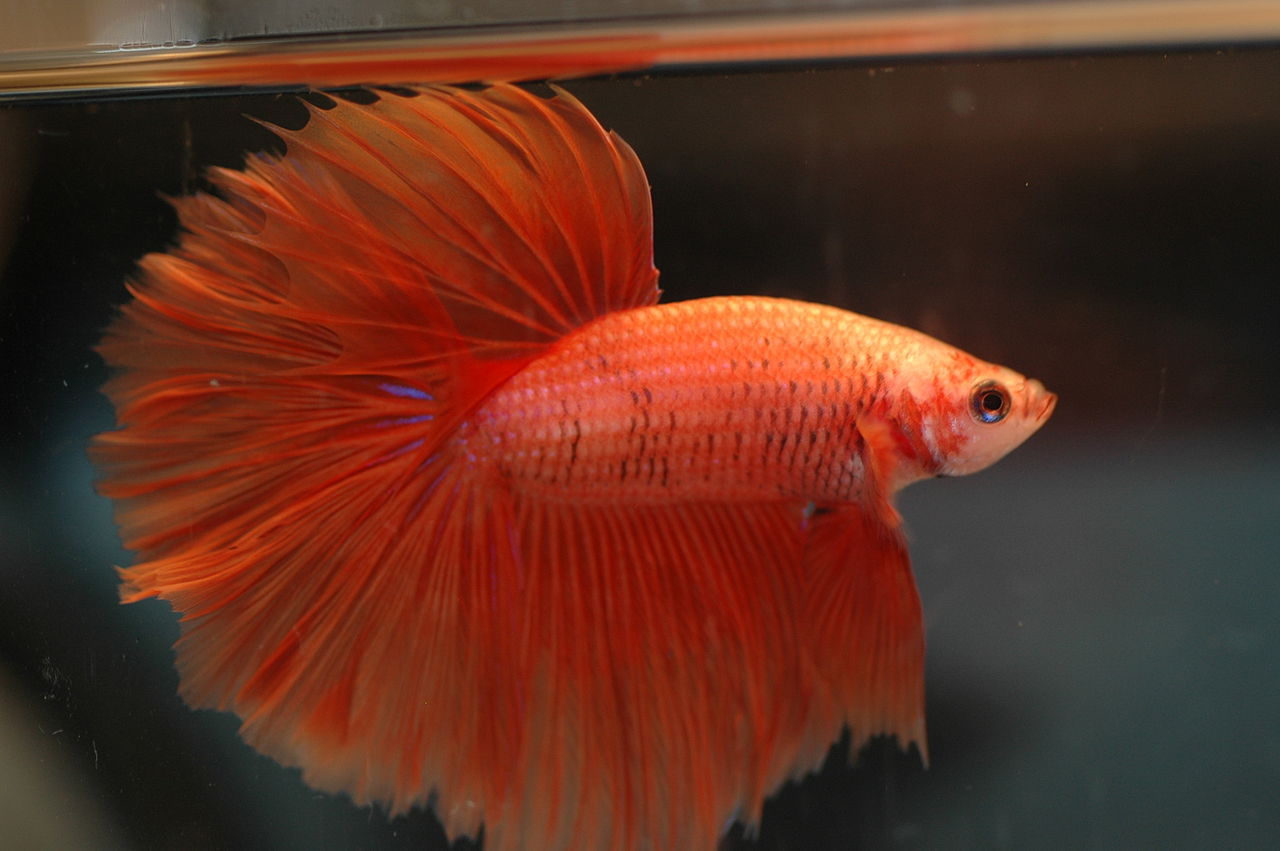
The ideal water temperature for Betta Fish is around 27 degrees Celsius (80 degrees Fahrenheit), and they can die if the temperature goes under 24 (75) degrees. Ensure that the heater is always on and set at the right temperature.
Origin
One of the most popular fish for major aquarists for their colors, and commonly found in most freshwater streams ponds of Southeast Asia! Bettas have skyrocketing popularity when it comes to aquascaping!
Diet
The Siamesefighting or Betta fish is a predatory fish; as you can guess, the best food for your fish will be the food source that is rich in protein!
The bettas mainly feed on insects or small invertebrates like larvae in their natural habitats!
So, what is it that you should feed your bettas? You can use specially formulated betta pellets or flakes. These flakes contain the nutrients your fish need to grow and develop colors!
Again, when you use the betta flakes as a staple dish, do not forget to give them some treats. You can use shrimps and worms as treats, but it should be limited, as bettas are very greedy!
#4 The Platies (Xiphophorus maculatus)
Care Chart
| Experience Level | Beginner |
| Fish Size | 3 inches (7.62 cm average) |
| Tank Size | 10 Gallon (45 Litres) for six platyfish |
| Temperament | Peaceful |
| Substrate | Medium sand, rock, and gravel works pretty good |
| Lighting Needs | Moderate during the day, low at night |
| pH Range | 6.8 – 8. 0 |
| Water Movement | Low |
| Water Hardness | 10 – 28 dGH |
| Temperature | 70 – 77 degrees Fahrenheit |
| Life Span | 2 – 3 years |
| Care Level | Easy |
These fishes are favorite for beginners, especially those with children because they need little to no maintenance. The males have more coloration and a thinner body, while the females are gray with a colorful tail.

Platies can produce up to 50 babies every month, starting with only a few fish and waiting for the family to grow. Ensure that the babies have places to hide, like plants or decorations, so other fish will not eat them.
The water needs to be between 22-24 degrees Celsius (71-75 degrees Fahrenheit); therefore, a heater may or may not be required depending on the environment around you. They are small, colored, and active, providing your aquarium with a pleasing look!
Origin
The platies are native to Mexico and Central America! The two most common Platy species are Xiphophoorus Maculatus (Southern Platy) and Xiphophorus Variatus (Variable Platy).
Platies are generally crossed with Swordtails. And there are several species of cross-bred platies available in the market!
Diet
Platy fish species are omnivores! Generally, when in their natural habitats, these fish species feed on plant matter, algae, crustaceans, and insects. However, platies need vitamins, as vitamins help them develop their colors.
These fish are not picky at all when it comes to food, but this does not mean they do not treats! You can use greens like spinach, lettuce, cucumber, and flake food as a staple diet for your Platies!
Again, you can use tubifex, shrimps, and some bloodworms as treats for your fish!
Also, when it comes to feeding the platies, only give them the food they can eat in three minutes. And it is also a fact that juveniles need a lot of food, so you have to feed them a couple of times a day.
The adults are to be fed twice a day!
#5 The Tiger Barb (Barbus Tetrazona)
Care Chart
| Experience Level | Beginner |
| Fish Size | 2 – 3 inches (7.62 cm average) |
| Tank Size | 20 Gallon (75 Litres) |
| Temperament | Playful, yet aggressive |
| Substrate | fine gravel substrate with some rock at the bottom, along with submerged vegetation |
| Lighting Needs | Basic or standard hood lighting |
| pH Range | 6.8 – 8.0 |
| Water Movement | Low-flow for imitating their natural habitats |
| Water Hardness | 10 – 28 dGH |
| Temperature | 75 – 82 degrees Fahrenheit |
| Life Span | 5 – 7 years |
| Care Level | Easy to Moderate |
If you want some active fish to change the aspect of your aquarium tank, the small, striped Tiger Barb fish are precisely what you need. They live in a group with perfectly synchronized movements, making them entertaining.
If the aquarium is large enough, you can add 15 to 20 fish. They are slightly aggressive, but they will never attack each other; it is better to keep them separated from bigger fish. Their more giant companions can create problems by teasing or poking them.
The ideal water temperature for the Tiger Barb is 25 degrees Celsius (77 degrees Fahrenheit), and other than the temperature, as long as they are fed, you are free to enjoy the spectacle!
Origin
This species of fish has interesting personalities as enjoyable as their colors. This fish is native to Sumatra and Borneo and often goes by the name of Sumatra Barb.
Furthermore, this fish species got unimaginably popular in this hobby and has a significant population spread wildly across the United States and Puerto Rico.
Diet
Like most freshwater fish such as bettas, angelfish, and platies, the Tiger Barbs also feed on plant matters, worms, zooplankton, and other smaller vertebrates.
Tiger Barbs have a different love for zooplanktons, and as your tank is in no way similar to a lake or stream, you may have some difficulties replicating the same!
When feeding Tiger Barbs, adult brine shrimps white fleas work pretty well. And, larval brine shrimps work the best for the juveniles.
Also, if you are planning to feed them live invertebrates, consider frozen and dried bloodworms or pellet foods.
Furthermore, your fish would live happily if you provided them with a varied diet, but greens are a must as they help your fish to develop their colors.
Barbs will feed on the algae grown in the tank, but you can also provide them with boiled cucumber, lettuce, and zucchini.
#6 The Zebra Fish (Danio Rerio)
Care Chart
| Experience Level | Beginner |
| Fish Size | 2 inches (5.08 cm average adult) |
| Tank Size | 10 Gallon (45 Litres) for six platyfish |
| Temperament | Playful, and peaceful |
| Substrate | Depends on how you use it but keeping floating plans is pretty vital |
| Lighting Needs | Basic or standard hood lighting |
| pH Range | 6.5 – 8.0 |
| Water Movement | Moderate flow for imitating their natural habitats |
| Water Hardness | 5 – 12 dkH |
| Temperature | 64 – 78 degrees Fahrenheit, use a heater |
| Life Span | 4 – 5 years |
| Care Level | Easy |
This small species of fish is excellent if you are looking for fish without high requirements. These tiny, striped, good-looking Zebra Fish make them fit in any decor, while their dynamic behavior makes them fun to watch.
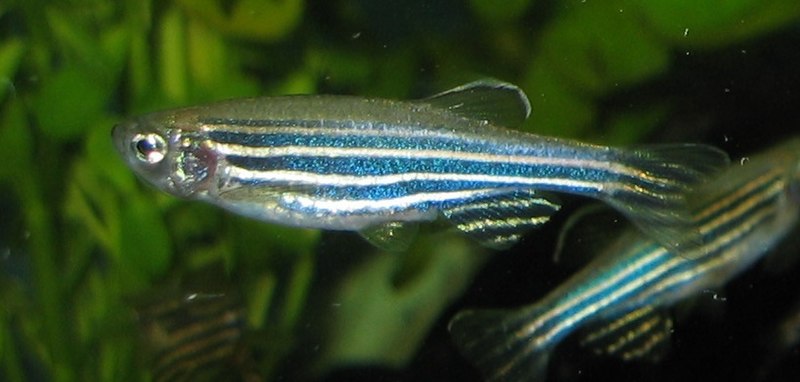
They live in a group, so you should consider getting at least 8-10 small fish. One fantastic thing about the Zebra Fish is that they can live in cooler temperatures between 18 to 26 degrees Celsius (64-78 degrees Fahrenheit). If the temperature is correct, you can easily keep the aquarium without a filter. In addition, they need plenty of space for swimming; therefore, you should not add too many tall plants.
Origin
The Zebrafish comes from a wide range that stretches from Myanmar to Pakistan! But, over time, this stretch becomes shrined and narrower, and now most fish come from India and Bangladesh!
This happened due to the misidentification of a similar species known as Danio rerio! And not to mention the environmental damages as they destroyed the natural habitats of the fish.
Diet
Zebras are primarily omnivores who love Aqueon color flakes, tropical flakes, shrimp pellets, and granules.
You can also treat them occasionally with live foods as they affect spawning. To make the best out of it, rotate their foods daily and only give them the food they can finish off within two minutes!
#7 The Angel Fish (Pterophyllum Scalare)
Care Chart
| Experience Level | Beginner |
| Fish Size | 3 – 4 inches (10.16 cm average adult) |
| Tank Size | 20 Gallon (75 Litres) for six platyfish |
| Temperament | Peaceful, yet semi-aggressive |
| Substrate | Soft mud or sand |
| Lighting Needs | Basic to standard lighting |
| pH Range | 6.8 – 7.0 |
| Water Movement | Moderate flow for imitating their natural habitats |
| Water Hardness | 4 – 12 dGH |
| Temperature | 75 – 82 degrees Fahrenheit, use a heater |
| Life Span | 10 – 12 years |
| Care Level | Easy |
Angel Fish are some of the most beautiful, but slow fish. No matter how much space they have, they will not swim too much and they are generally not as active. Keeping them alone in the aquarium or with other similar species is recommended since active fish, like the Platies or Zebras, can hurt them. The recommended temperature is around 24 degrees Celsius (75 degrees Fahrenheit), so a heater is necessary.

The most important requirement that you need to consider for this fantastic fish is the quality of the water; they are sensitive to nitrates. Consistently check the balance of the water to keep your aquarium healthy.
Origin
Angelfish is one of the most popular fish species when it comes to this hobby! These fishes are large, wide, full of colors, and are pretty hardy in nature. And it is very to care of them. They are generally peaceful but can go berserk sometimes.
Originated from South America. And it has a massive population throughout the Amazons, Brazil, French Guiana, Guyana, Peru and Columbia.
You can easily find them in slow-moving streams, swamps, floodplains, and acidic waters with no salinity.
Diet
Like every other freshwater fish in the wild, the Angelfish also feeds on teeny-tiny live prey, including larvae and crustaceans.
Well, you can easily replicate their favorite food. All you can do is provide them with some greens and something rich in fiber and protein.
So, try feeding the angelfish some tubifex worms as they are rich in protein. You can also feed them the angelfish some fleas, and brine shrimps as well.
Keeping aside the live preys, you can provide them with pellets or fish flakes and small amounts of greens such as zucchini or spinach. These are rich in fibers!
You do not need to feed them quite often, just two feedings a day, and it is done. Give them only a pinch of food, or provide them the amount of food that they can finish in three minutes.
If you find leftovers, clean it off!
Frequently Asked Questions
What The Best Freshwater Fish Species That I Can Keep Together?
There are plenty of freshwater fish species that can live together peacefully. And they are – Guppies, Mollies, Platys, Loaches, Plecos, Tetras, Swordtails, and Raspboras!
Not only can these fishes live together, but also it takes less of an effort to maintain them! It is pretty easy to care for them and feed them!
What Is The Best Hardy Freshwater Fish?
There are many hardy freshwater fishes, like Angelfish. But, one fish that is hardier than Angelfish itself is Danios!
Their hardiness makes them easy to keep, and it is the best choice for an individual who does not have any experience setting up tanks and looking after them!
Is Catfish A Freshwater Fish?
If you wish to keep a catfish in the tank that is amiable, the perfect choice is the Cory Catfish!
These are pretty friendly and can go well with any fish species in your tank. Also, these help keep your tank clean, and you love to eat veggies and bloodworms.
These fish have a pretty long life and can be a staple fish for your tank! If you are up for keeping this, keep at least three of them.
Cory has a pretty unique look, needs a bit of care, but is genuinely a great fish to have in your tank!
Conclusion
All fish are spectacular if you treat them with care. It depends entirely on you if you prefer something more colorful, simple, or how active the fish are in the tank. Use your imagination and create something that reflects your artistic vision. Fishkeeping is a passion, a hobby, and as long as you have a healthy aquarium, anything is permitted!
